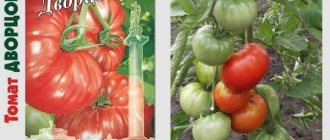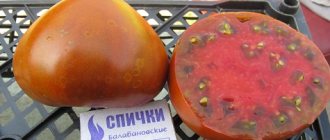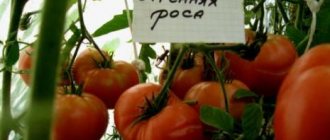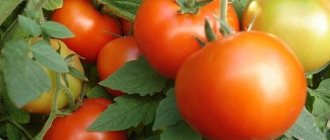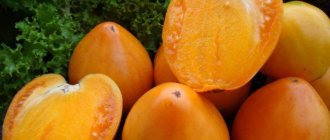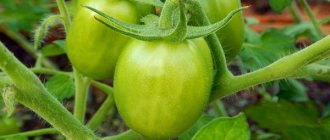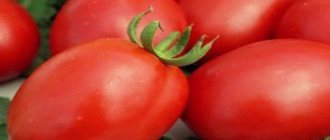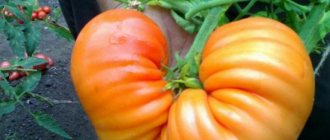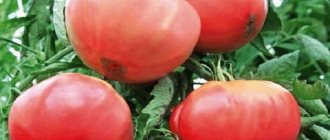An excellent choice for hot, temperate, and cool regions is the Mishka clubfoot tomato. The fruits are large in size, fleshy and tender. Agricultural technology is simple and straightforward; with a little work, you can harvest significant tomato yields. Heart-shaped giants look beautiful and appetizing, great for summer and winter dishes.
| Height | Landing location | Ripening time | Fruit color | Fruit size | Origin | Fruit shape |
| Tall | Greenhouse, Open ground | Mid-season | Reds | Large | Variety | Heart-shaped |
Description and characteristics of the variety
The variety is included in the indeterminate tall group. The height of a tomato bush reaches 2 m or more. Among the main features of the escapes:
- 3-5 tomatoes are tied on fruiting clusters;
- foliage and branching are moderate;
- foliage is dark green, medium in size;
- excessive vegetation;
- pinching of the top is required.
Tomato Mishka clubfoot from “Ural Summer Resident”, also known as “Ural Estate”, ripens in an average time - 112-124 days from germination.
It has time to ripen in the middle zone - the Moscow region, and in the central regions - in open beds. In northern conditions, cultivation is carried out in greenhouse conditions until the temperature stabilizes.
Fruit criteria:
- average weight 600 g;
- the weight of large tomatoes reaches 0.9-1 kg;
- shape like a heart;
- the skin is strong, not cracking;
- 5-6 seed chambers, few seeds;
- the flesh is fleshy, tender, moderately juicy;
- sweetish notes dominate the taste;
- sugar level 5-5.2%.
The variety is presented in several varieties depending on the color of the fruit. There are red, yellow, raspberry and pink varieties of tomatoes.
General recommendations for planting and care
The tomato variety Mishka clubfoot is most often grown in seedlings. It is important to comply with all agrotechnical requirements. Particular attention should be paid to the composition of the soil for planting seeds and seedlings when picking.
Planting seeds and growing seedlings
Planting material is planted at the end of March. The soil mixture must be of high quality and rich in useful elements. Most often, gardeners purchase soil in specialized stores, but you can prepare it yourself.
The composition of the soil mixture should be as follows:
- fertile land (ideally black soil) – 2 parts;
- manure (humus) – 1 part;
- peat or river sand - 1 part.
You will need to add wood ash and superphosphate (300 g each) to the mixture. An important point is the preparation of Mishka clubfoot seeds. To begin with, they are placed in salted water (1 tablespoon of salt per liter of water). The floating grains are drained along with the liquid. The rest are dried. Disinfect in a solution of potassium permanganate for 30 minutes and dry again. To ensure that seedlings appear smoothly, gardeners use growth stimulants, for example, Epin. Dissolve 5 drops of the drug in a liter of water and soak according to the instructions. To grow seedlings on a windowsill, the grains should be hardened off. It is enough to place a gauze bag with seeds in the refrigerator for 2 days.
Planting material is planted in prepared and slightly moistened soil. The depressions are made to a depth of 1 cm. After immersion, the seed is sprinkled with earth on top. The containers are placed in a warm, sunlit place. The temperature must be at least 24°C.
Picking and transplanting into open ground
With the appearance of the first two leaves, picking begins. Use disposable plastic cups or special cassettes. A new soil mixture is prepared, but the sprouts are replanted along with the earthen ball. To quickly adapt to a permanent location, the sprouts are hardened off. To do this, the containers are taken out into the fresh air every day, while gradually increasing the time spent on the street. As soon as 4 leaves grow on the sprout, the ground is fertilized with ammonium nitrate.
They are transplanted into open ground when the seedlings are 60 days old. This falls at the beginning of May. The main thing is that the earth warms up to 10°C. When transplanting, adhere to the 40x50 pattern. Bushes are formed into two stems. The holes are prepared to such a depth as to immerse the seedling up to the first leaves.
Expert opinion
Stanislav Pavlovich
Gardener with 17 years of experience and our expert
Ask a Question
Important! It is recommended to cover the tomato bushes for the first 14 days after transplantation, since frosts are possible during this period.
Watering and fertilizing mode
Tomatoes should be watered rarely (about once every 3 days), but abundantly. This will contribute to the proper development of the root system and maximum absorption of nutrients from the soil. Water is used that is settled and not cold. The liquid consumption per bush is about 4 liters. Water at the roots, without getting on the leaves.
See also the Main characteristics, description and productivity of the Klusha tomato
Since the large-fruited variety loves fertilizers, the bushes will have to be fed on a regular basis.
Complex fertilizers are applied:
- 2 weeks after transplanting the seedlings, Mishka clubfooted into open space. This can be any organic fertilizer, for example, chicken droppings, ash, mullein.
- 7-8 days before flowering, add a solution of ammonium nitrate (100 g of raw material per 5 liters of water). Fertilizer will help improve the formation of inflorescences and flowering.
- During fruit ovation, superphosphate is used. The solution is prepared from 10 liters of water and 400 g of the drug.
- 7-8 days before the complete harvest of the entire crop, pour a solution of potassium nitrate under each tomato bush. For 10 liters of water, take 300 g of product.
Expert opinion
Stanislav Pavlovich
Gardener with 17 years of experience and our expert
Ask a Question
Attention! It is better not to use fresh manure as fertilizer. It actively influences the development of green mass, not fruits. It is better to use rotted manure (humus).
Formation of tomato
It is important to pay special attention to this process, since the further harvest of the Mishka clubfoot variety depends on the correct and timely formation of crop bushes. Experienced gardeners advise first to remove the top of the bush to stop growth and cut off all deformed leaves and flowers. Bushes are formed into two stems. Side shoots and stepsons are removed.
Preventive spraying
The most common diseases of Solanaceous crops are tobacco mosaic, late blight, gray rot, and black leg. To prevent the development of infection, it is necessary not only to comply with all agrotechnical requirements, but also to use solutions for spraying bushes.
What means are used:
- boric acid (4 drops per 4 liters of water);
- peroxide and iodine (for 10 liters of water, 1 tablespoon of peroxide and 40 drops of iodine);
- brilliant green (45 drops of product per 10 liters of water);
- potassium permanganate (1 g per 1 liter of water);
- whey (1 liter per 10 liters of water);
- furatsilin (10 tablets per 10 liters of water);
- calcium nitrate (1 tbsp per bucket of water).
To protect bushes from pests, insecticidal preparations are used. For example, Iskra, Fitoverm, Actellik, Tanrek, Decis. Dilute all medications in water according to the instructions.
Origin and application
The variety was obtained by Russian breeders. Designed for planting in various regions. Grown:
- in Crimea, Krasnodar in open beds;
- in the Volga region and Moscow region in greenhouses at the beginning of spring, and then without shelter;
- in Siberia and the Far East in greenhouse beds.
The fleshy fruits are widely used in cooking. In the summer they prepare light vitamin salads, cuts for burgers and sandwiches. Sweetish thick juices, pastes and sauces are made from winter preparations. Add to assortment, marinate and dry-dry in pieces.
Advantages and disadvantages
Positive properties of the variety:
- excellent taste;
- high content of nutrients;
- ease of care;
- disease resistance;
- high productivity;
- good transportability.
The variety has practically no disadvantages, except for its demands on fertilizing and pinching. Against the background of positive characteristics, minor shortcomings are invisible, which is why many vegetable growers prefer this particular tomato.
Features of cultivation and storage
Planting of bushes on permanent beds is carried out when the seedlings are 55-60 days old.
To increase productivity, areas are fertilized in advance. For 1 m2 add:
- 1 bucket of compost;
- 25 g superphosphate;
- 15 g potassium sulfate;
- 1 cup wood ash.
The variety needs full fertilizing, which is carried out every 2 weeks. The most effective means:
- 1:10 diluted mullein solution;
- saltpeter;
- phosphorus-potassium mixture;
- bioinfusions;
- wood ash.
The formation of bushes is carried out in 1-2 trunks.
Review Reviews
Summer residents speak mostly positively about the Mishka clubfoot variety. Many gardeners are pleased that even if the fruits did not have time to ripen before the onset of frost, they can be picked green - they will ripen successfully even without a bush. This characteristic allows even residents of the northern regions to enjoy a bright and tasty vegetable. Reviews from summer residents - further.
Alexey, Tomsk: “That year I grew the tomato variety Mishka clubfoot on my plot. I purchased seedlings ready-made at the market. Since I don’t have a greenhouse, I transplanted the plants into open ground. Over the entire summer I applied 3-4 additional feedings. I used superphosphate and humus for this. The bushes grew tall and there were a lot of ovaries. Some fruits were collected green and then stored in the pantry. After a week, the tomatoes ripened and became sweet.”
Vera, Ulan-Ude: “In my city the climate is unpredictable. For many years now, I have always been trying to grow new varieties of tomatoes in the greenhouse. A neighbor advised me to plant a tomato called Mishka clubfoot. I cultivated several varieties of this vegetable. The fruits have grown large and beautiful, as in the photo of the package with seeds. The culture, of course, requires a little attention, but always pleases with an abundant and high-quality harvest. In general, I liked the tomato variety Mishka clubfoot.”
Variety varieties
Breeders have developed several subspecies of the variety, the color of the fruits of which is not only red.
- The bushes of the yellow subspecies are indeterminate and grow up to two meters. From the name it is clear what color the fruits are. Their flesh is fleshy and sweet in taste. The average weight of tomatoes is 800 grams. An important feature is that the yellow Teddy bear never gets sick with such traditional nightshade diseases as Alternaria, tobacco mosaic, and fusarium. The orange subspecies is also tall and requires constant pinching and gartering of branches. Only 2 stems are left on each bush. The color of ripe fruits is bright orange and their ribbed, heart-shaped shape. The weight of one tomato often reaches 900 grams. This subspecies is also disease resistant.
- The pink subspecies is quite tall, growing up to one and a half meters. The leaves on the branches are small. Fruits with a glossy surface look like an elongated ellipse. This subspecies is characterized by high productivity with an average ripening period of giant fruits. They weigh approximately 900 g to 1 kg.
- The red subspecies (or crimson) is characterized by larger leaves. The stems grow up to 1.9 m. The fruits are also large, weighing up to 900 g. They taste sweet. This subspecies is grown in greenhouses.
The tomato Tender Misha f1 is also receiving positive reviews.
How to care for tomatoes
The Clubfoot Bear needs care no less than other plants on the site. By implementing agricultural techniques in a timely manner, they achieve high yields and high resistance to diseases.
Watering
Water the plants in a timely manner, abundantly and infrequently. Moisten after the top layer of soil dries. To retain moisture in the soil, mulch or loosen.
Top dressing
The Mishka Kosolapy tomato, which is demanding on soil fertility, needs to be fertilized. Do this at least 3-4 times during the growing season.
- 14 days after transplantation;
- before flowering;
- during the formation of the ovary;
- during ripening.
Mineral fertilizers alternate with organic matter.
Hilling
The process stimulates the appearance of additional roots. Also, the loosened top layer of soil provides oxygen access to the root system.
Stepsoning
All stepsons that form above the first brush are removed. Grow bushes with 2 stems, this way maximum yield is achieved.
How to tie tomatoes
The supports must be strong and stable; construct stakes or trellises. Tomatoes are tied up so that the plants have freedom for further growth.
A tightly and tightly tied stem grows up to a certain point, then the garter material (rope, twine, pieces of fabric) is cut into the stem. The overstretched shoot bends and stops receiving water and nutrients. The bush dies.
Protection from pests and diseases
The best defense is prevention. Summer residents advise following planting technology, applying fertilizers and watering bushes in a timely manner. Loosen, hill up and mulch the soil near the tomatoes.
If signs of disease or the presence of insects appear, treat with chemicals or traditional methods of control.
Transplanting seedlings
Transplant into a greenhouse in May, when the soil has warmed up sufficiently after frost. The minimum ground temperature is 10 °C. By this time, the seedlings will have already formed 3 pairs of leaves. If the soil does not warm up, you can postpone the replanting process for several days.
Gardeners often transplant flowering seedlings into open ground: this does not affect the growing season of the plant.
Many gardeners try to grow and plant seedlings already with flowers, wanting to get a harvest as early as possible. But the larger the seedlings, the worse they tolerate transplantation. After transplantation, seedlings with flowers “sick” for a long time and lose their growth spurt.
Basic rules when transplanting seedlings:
- keep a distance between bushes of 50 cm;
- the row space must be at least 60 cm;
- form the plant into 2 stems;
- pinch the growing point.

